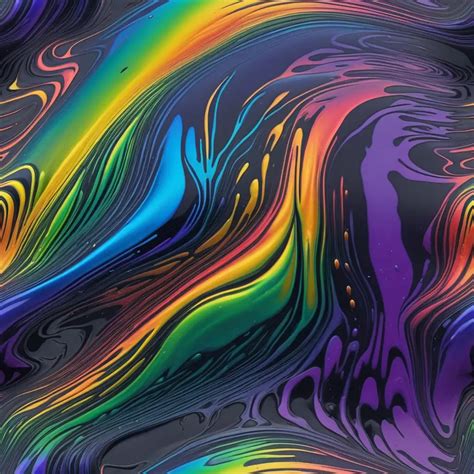Introduction

Oil slick colors, known for their iridescent and captivating hues, have captivated nature enthusiasts and scientists alike. These vibrant patterns, often observed on the surface of water bodies or oil spills, result from the interference of light with the thin films of oil or other liquids. The intricate interplay between light and matter gives rise to an array of colors that dance and shimmer before the naked eye.
The Physics of Oil Slick Colors
The mesmerizing colors of oil slicks are governed by the principles of thin-film interference. When light rays strike the surface of an oil film, they undergo partial reflection and partial transmission. The reflected and transmitted rays then combine to produce a vibrant and colorful effect.
The thickness of the oil film plays a crucial role in determining the colors observed. As the thickness changes, the amount of light reflecting off the film also changes, resulting in a shift in color. The precise wavelengths of light that are enhanced or attenuated by interference depend on the specific thickness of the film.
Applications and Innovations
The vibrant and captivating nature of oil slick colors have inspired researchers to explore their potential in various applications. Here are a few intriguing examples:
1. Art and Design
Oil slick colors have become a popular medium for artists and designers. They utilize the shimmering and iridescent effects to create captivating paintings, sculptures, and jewelry. The unique and ever-changing nature of these colors adds depth and visual interest to artworks.
2. Optical Sensors
Thin films and their interference patterns have been employed in the development of optical sensors. These sensors exploit the sensitivity of the color to changes in the film’s thickness, enabling applications in areas such as chemical sensing, environmental monitoring, and medical diagnostics.
3. Advanced Materials
The study of oil slick colors has led to the development of advanced materials with unique optical properties. These materials exhibit tunable colors and can be engineered for specific applications, such as optical coatings, self-cleaning surfaces, and bio-inspired sensors.
Sustainability and Environmental Concerns
While oil slick colors can be mesmerizing, they also raise concerns regarding environmental pollution and the impact on aquatic life. Oil spills and natural oil seeps can result in the formation of large oil slicks, which disrupt marine ecosystems and pose risks to wildlife.
Efforts are underway to develop effective oil spill cleanup technologies and to minimize the environmental impact of oil slicks. These include the use of absorbents, dispersants, and biological remediation techniques.
Customer Wants and Needs
Customers and end-users seeking products and services related to oil slick colors have specific wants and needs. These include:
- High-quality, durable products that retain their vibrant colors over time.
- Versatile materials suitable for multiple applications, such as art, design, and optical sensors.
- Environmental consciousness and the use of sustainable practices in the production and disposal of oil slick products.
Effective Strategies
To meet the demands of customers, businesses and organizations can adopt the following effective strategies:
- Invest in research and development to create innovative products and technologies that leverage oil slick colors.
- Collaborate with artists and designers to explore new applications and inspire creative expression.
- Promote sustainability by using environmentally friendly materials and reducing the environmental footprint of oil slick products.
Tips and Tricks
For those working with oil slick colors or studying their properties, here are some tips and tricks:
- Use a variety of light sources at different angles to observe the full spectrum of colors.
- Experiment with different film thicknesses by controlling the thickness of the oil or liquid layer.
- Consider the surrounding environment and how it affects the appearance of the oil slick colors.
- Seek inspiration from nature and explore the diverse ways oil slicks form and interact with light.
Tables
Table 1: Thickness-Color Relationship for Oil Slicks on Water
| Thickness (nm) | Color |
|---|---|
| 100-150 | Blue |
| 150-200 | Green |
| 200-250 | Yellow |
| 250-300 | Orange |
| 300-350 | Red |
Table 2: Applications of Oil Slick Colors
| Application | Purpose |
|---|---|
| Art and Design | Aesthetics, visual interest |
| Optical Sensors | Chemical sensing, environmental monitoring |
| Advanced Materials | Tunable colors, self-cleaning surfaces |
| Environmental Research | Studying pollution impacts, oil spill cleanup |
Table 3: Customer Wants and Needs for Oil Slick Products
| Want or Need | Explanation |
|---|---|
| High quality, durable | Long-lasting vivid colors, resistance to fading |
| Versatility | Suitable for multiple applications, such as art, design, and sensors |
| Environmental consciousness | Sustainability, reduced environmental impact |
Table 4: Strategies for Businesses and Organizations
| Strategy | Description |
|---|---|
| Invest in R&D | Develop innovative products leveraging oil slick colors |
| Collaborate with artists and designers | Explore new applications and foster creativity |
| Promote sustainability | Use eco-friendly materials, minimize environmental footprint |
